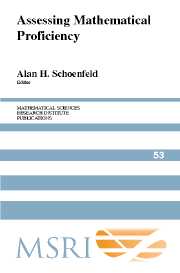Book contents
- Frontmatter
- Contents
- Preface
- Acknowledgments
- Section 1 The Big Picture
- Section 2 Perspectives on Mathematical Proficiency
- 4 What Is Mathematical Proficiency?
- 5 What Is Mathematical Proficiency and How Can It Be Assessed?
- Section 3 What Does Assessment Assess? Issues and Examples
- Section 4 The Case of Algebra
- Section 5 What Do Assessments Assess? The Case of Fractions
- Section 6 The Importance of Societal Context
- Epilogue: What Do We Need to Know? Items for a Research Agenda
- About the Authors
- Subject Index
- Author Index
- Task Index
5 - What Is Mathematical Proficiency and How Can It Be Assessed?
Published online by Cambridge University Press: 06 July 2010
- Frontmatter
- Contents
- Preface
- Acknowledgments
- Section 1 The Big Picture
- Section 2 Perspectives on Mathematical Proficiency
- 4 What Is Mathematical Proficiency?
- 5 What Is Mathematical Proficiency and How Can It Be Assessed?
- Section 3 What Does Assessment Assess? Issues and Examples
- Section 4 The Case of Algebra
- Section 5 What Do Assessments Assess? The Case of Fractions
- Section 6 The Importance of Societal Context
- Epilogue: What Do We Need to Know? Items for a Research Agenda
- About the Authors
- Subject Index
- Author Index
- Task Index
Summary
To establish a common point of departure with Jim Milgram's chapter, this chapter is framed around the two basic questions with which his chapter began:
What does it mean for a student to be proficient in mathematics? (What should students be learning?)
How can we measure proficiency in mathematics? (How can we tell if we are succeeding?)
My main emphasis is on the first question, because much of the rest of this volume addresses the second.
In the introduction to this volume and in the first chapter, I pointed to the fact that the “cognitive revolution” (see [Gardner 1985], for instance) produced a significant reconceptualization of what it means to understand subject matter in different domains (see also [NRC 2000]). There was a fundamental shift from an exclusive emphasis on knowledge—what does the student know?—to a focus on what students know and can do with their knowledge. The idea was not that knowledge is unimportant. Clearly, the more one knows, the greater the potential for that knowledge to be used. Rather, the idea was that having the knowledge was not enough; being able to use it in the appropriate circumstances is an essential component of proficiency.
Some examples outside of mathematics serve to make the point. Many years ago foreign language instruction focused largely on grammar, vocabulary, and literacy. Students of French, German, or Spanish learned to read literature in those languages—but when they visited France, Germany, or Spain, they found themselves unable to communicate effectively in the languages they had studied.
- Type
- Chapter
- Information
- Assessing Mathematical Proficiency , pp. 59 - 74Publisher: Cambridge University PressPrint publication year: 2007
- 6
- Cited by



